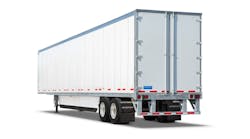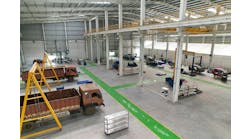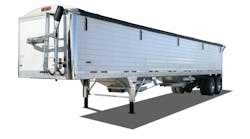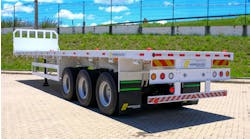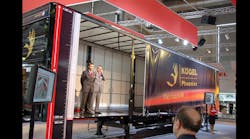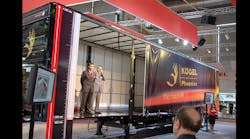Latest from Trailers
Tata launches Re.Wi.Re CV recycling program
Randon marks export milestone
Wabash expands parts network
Nearly 300,000 people from 110 countries saw the latest truck body and trailer ideas at the IAA Commercial Vehicle Show in Hannover, Germany.
The event, which closed October 2, had exhibits from 2,084 companies, up 30% from the previous show, in 2006. It is sponsored by the VDA, the German automotive industry association.
In 2010, the IAA Commercial Vehicle show opens in Hannover on Thursday 23 September and closes on Friday 1 October. Here are some highlights from the most recent IAA show (View photos that accompany these write-ups in the related media gallery):
New carbon-fiber trailer. An innovative thin-deck trailer featuring strategic use of carbon fiber was unveiled by Kögel Fahreugwerke GmbH of Burtenbach, Germany.
The thin-neck design produces a three-meter inside height and yet keeps the trailer within Germany's four-meter overall height limit.
The trailer achieves the three-meter (118-inch) inside height by trimming the deck thickness of the trailer in the upper coupler area to a mere 49 mm (1.9 inches). As a result, the trailer can carry one-meter-high pallets stacked three high, rather than only two.
Doing so, however, took some detailed engineering.
“We began studying ways to use carbon fiber in trailer manufacturing over two years ago,” says Paul Stempfle, engineer for Kögel. “We learned that there is a lot of interest on the part of customers.”
Kögel previously showed a trailer with a deck thickness in the upper coupler area of 55 mm (2.16 inches). The company's latest version is even thinner.
Stempfle says the company explored the possibility of making the entire trailer chassis with carbon fiber but quickly concluded that such an approach would be cost prohibitive and unnecessary. Expensive carbon fiber is not required throughout the trailer. Instead, Kögel developed a design that uses carbon fiber where it is needed most — the high-stress area above the fifthwheel.
The upper coupler area is a carbon fiber deck, while the main beam and cross sills behind the upper coupler area are made of high-strength steel. The main beams transition from carbon fiber to steel through an aluminum casting that is engulfed in carbon and glass fiber. The assembly — including deck and transition — bolts to the steel main beams.
“If there is an application for carbon fiber in a trailer, this is it,” Stempfle says. “We achieve the deck thickness customers want through the use of carbon fiber, and have a trailer with a tare weight of less than five tonnes. Just the use of the carbon fiber saves 250 kg (551 lb) compared with a 100-mm deck made of steel.”
And the deck thickness makes it possible to transport one-meter-high boxes three high instead of two.
The combination of carbon fiber and aluminum address the concern over cracking that early composite trailers have experienced, Stempfle says.
“We have conducted finite element analysis and real-world testing,” he adds. The testing included cycling the trailer with loaded forklifts and running fully loaded trailers over rough roads.
As with all Kögel vehicles, all steel parts on the Phoenixx M49 trailer are protected from corrosion by Nano Ceramic plus KTL - the latest in coating technology.
The body of the new high-cube trailer comes with a load safety certificate according to EN 12642 XL as standard, which certifies that the body is capable of securing a load without additional straps - even without drop-in slats.
The trailer is expected to be available in mid-2009.
Improved trailer aerodynamics. Undermounted compartments from Kögel Fahreugwerke GmbH reduces aerodynamic drag while providing generous storage capability for van trailers and platforms.
“About a third of the reduction comes from the sidewalls, and two-thirds from the floor,” says Paul Stempfle, Kögel engineer.
Kögel's Aeropaket DYNAMIX runs from just aft of the landing gear to the underride guard. It consists of four separate parts on each side of the trailer, which can be easily mounted and removed.
When installed, however, the Aeropaket provides two main storage areas — one ahead of the tandem and another behind it. The compartments can be completely enclosed and secured. Gas shocks hold each compartment door open.
The compartments essentially create wheel wells around the axles, which help smooth airflow and also reduces road spray. Unlike earlier generations, the new aerodynamically formed DYNAMIX paneling is made of shock-resistant ABS plastic, rather than laminated fiberglass.
The front container has enough room for 36 pallets. The rear compartment can hold eight more pallets or two spare tires, with room left over for tools.
Avoiding axle overload. Reduced load on the trailer rear causes a shift of the centre of gravity towards the front. The result: the tractor drive axle is overloaded. Schmitz Cargobull has now found remedy for mastering this “shift in weight” so that as cargo shifts, compliance doesn't.
The Schmitz Load Spread Program was developed to kill three birds with one stone: optimize load distribution, improve maneuverability, and reduce tire wear. By controlled reduction of the loading of the third trailer axle using bellows venting, the two front trailer axles are more heavily loaded. Consequently, the turning point of the unit is effectively shifted from the middle trailer axle to between the first and second axles. As a consequence, the load on the tractor rear axle is reduced, and ride and cornering are improved.
The driver can deactivate the automatic mechanism using a switch on the side operating console. In addition, it is possible to activate LSP using a button in the tractor. Then the system is even active up to a speed of 30 km/h (18.6 mph).
Slider container chassis. Kögel also unveiled its new Port-MAXX 40 multiplex container chassis with slider technology.
All controls are situated in a central position in the middle of the vehicle. The operator activates a single knob to extend or retract the chassis. If the driver actuates the release button, the brakes activate and the locking mechanism on the frame is automatically unlocked. At the same time a clear, repeated warning tone is produced. Now the driver can drive the cab forward until the frame is in the desired position. A rubber padded guide is fitted to assist. The control system now ensures that the frame is locked in this position. The warning signal is turned off and the brake control is set back to drive mode.
The slider technology enables the chassis to handle EU-conforming loads with 20 foot containers so that the drive axle is sufficiently loaded, even in winter.
The Port-MAXX 40 multiplex also can handle 30 foot and 40 foot high-cube containers. The chassis is also designed for tank containers of all hazard classes up to 30 tonnes.
Krone introduces the Box Liner. The new Box Liner SDC 27 eLTU6 container chassis is suitable for transporting 20-ft to 45-ft containers and two 20-ft boxes. Electronic operation controls the loading and unloading sequences. While viewing the control display, the driver selects the container to be transported, and the electronic system operates the pneumatic conveyor at the front and at the rear. The chassis comes standard-equipped with an electronic stability system (RSS). The chassis is a product of Fahrzeugwerke Bernard Krone GmbH, Werlte, Germany.
Getting into dumps. Dump trailers are a new product for Sommer Road Cargo Solutions, Bielefeld, Germany — at least for the Western European market. The company has been selling them in Eastern Europe and Africa. Because of the rough roads found in these markets, the specifications for Sommer dump trailers are heavier than what would otherwise be expected. The company is offering steel or aluminum bathtub dumps, including a model that recently won a gold medal at a tradeshow in Poland.
Having it both ways. Chereau Vehicules Frigorifiques considers itself a custom trailer manufacturer that specializes in providing special trailers for refrigerated operations. Shown here is the company's “Combined meat/plus” refrigerated trailer, a dual compartment van that carries hanging meat along one side and palletized cargo or other goods in a second longitudinal compartment. A honeycomb longitudinal sliding wall separates the two compartments in a choice of positions.
Looking back at the Futura. French trailer manufacturer Lamberet introduced its SR2 Futura refrigerated trailer at the previous IAA and now has more than 5,000 on the road — including 3,600 that were produced in 2007. With that as background, the company announced at this year's show that it would extend the warranty on its semi-trailer range to up to 10 years on its chassis corrosion-proofing. The main reason — a new powder-coat system that Lamberet now provides at its plant in Saint-Cyr-sur-Menthon. The company also announced some refinements to the design, including the addition of rubber cushions to provide extra protection for the stainless steel shell encased rear bumpers — along with its optional “intensive distribution package.” Designed for the rough use that comes when trailer loads cycle rapidly, the package includes reinforced upper coupler. The package builds on the Futura's 12-mm full steel frame corner brackets and flush-mounted door hardware.
Boxing it up. Carnehl Fahrzeugbau is an established dump trailer manufacturer, known in Europe primarily for its half-pipe design dump trailers, which introduced its box-design dump body. The Eastern European market is used to this type of design, and it is easier to repair than the half-pipe design, the company says. The design also allows the body to be heated by the truck exhaust. Heated bodies have not been offered in Western Europe since Euro IV exhaust regulations went into effect.
Aluminum dump trailer. Benalu, a French dump and tank trailer manufacturer displayed its newly designed Siderale all-aluminum dump trailer. The smooth side walls are aerodynamic, easy to clean, and accept graphics easily. It is available in volumes from 22 m3 to 26 m3 (29-34 cu yd). Benalu manufactures approximately 2,900 trailers annually. The company is based in Liévin, France.
Walking floor trailer debuts. Fliegl Trailer introduced its Power Floor model, a new walking floor semitrailer that combines high volume — about 91 m3 (119 cu yd) and a relatively low tare weight of 7,400 kg (16,314 lb). The trailer is equipped with a choice of 6- or 10-mm (0.24 or .39 inch) extruded aluminum floor profile, either smooth or textured.
The company is targeting agriculture, recycling, and the timber industries for its new entry. Fliegl Fahrzeugbau GmbH has been producing trailers for over 15 years.
Got urea? If so, you need a special tank trailer to transport it. The solution that will be sprayed into the exhaust systems of 2010-compliant diesel engines takes some special care — particularly to guard against freezing. This trailer from Schrader Fahrzeugbau is designed to keep the AdBlue aftertreatment solution within allowable temperature. The trailer is equipped with urea measuring systems, hydraulically operated pump, voucher printer, in-transit heating system, overfill protection, and brake interlock.
Humbaur Big One connects all. A container chassis designed to transport all common container sizes from 20 to 45 ft was the latest trailer from Humbaur GmbH, Gersthofen, Germany.
A company noted for its wide lineup of light- and medium-duty trailers, Humbaur has branded its truck trailer line “Big One,” including its new container chassis, the Connect. The Big One Connect is a galvanized modular chassis that has a welded gooseneck and frame with a pneumatically controlled rear extension. Each component can be separated easily. Should one component become damaged, another can be slipped into place while the damaged one is repaired.
The Big One Connect has a curb weight of approximately 5.5 tonnes (12,125 pounds) and a permissible gross vehicle weight of 41 tonnes (90,389 pounds).
High cross rigidity of the basic frame in the rear area promotes stability. Safety features include adjustable underride guard, electronically controlled braking system, and a stability control system with dosed braking, and side-collision protection.
Truck transporter. The Flex Carrier trailer from Kässbohrer Fahrzeugwerke GmbH is designed to transport three while conforming to size and weight regulations from a variety of countries in Europe through a range of ramp configurations and the use of 17 ½ inch tires to drive down the deck height.
Spreading its wings. There is more than one way to access the entire side of a trailer, including this Wingliner design that places the entire sidewall on the roof. Wingliner International's new Swingliner design uses a patented drive mechanism to get the sidewall up and out of the way. The original Wingliner System was invented in 1996 by Johann Strasser.
Ups and downs. The Ruthmann Cargoloader makes it possible to load a truck body at conventional loading dock height and unload it on the ground. Ruthmann GmbH offers the system in three configurations, including straight truck and trailer models. Shown here is the “parallel” version, named for the fact that it keeps the truck body parallel to the ground.
Bending in the middle. Remember those roll-back bodies that offered lower deck heights by bending in the middle? They are back, at least at IAA. French truck manufacturer Peugeot demonstrated this chassis that features sliced frame rails that hinge immediately behind the cab. With the frame hinged, the body is powered down for easy dismounting.
Tire test trailer enables researchers to test tires for a wide range of variables — including the rolling resistance of the tire or the hub. A diesel engine generates the power for the electric and hydraulic equipment used for testing the tires and capturing the data. The test trailer can conduct experiments in a lab, or it can record real-world data while traveling streets and highways. In doing so, researchers can evaluate not only the tire, but also the validity of the lab tests. The trailer is the result of a joint effort between IKA (a university) and FKA (the commercial partner). FKA has a U S office in Southfield MI.
Stop and drop. Stub axles make it possible for this demountable truck body to be lowered to the ground and left behind. The configuration shown here has a gross vehicle weight of 3,500 kg (7,716 lb) and a payload rating of approximately 800 kg (1,764 lb), with GVWs of up to 4000 kg (8,818 lb) and payload ratings of up to 1,250 kg (2,755 lb). The van body is raised and lowered by means of an electro-hydraulic pump in a matter of seconds. The company, Heimann Fahrzeugbau GmbH & Company, also offers the concept in trailer versions.
Ultimate low floor. The Niederflurhubwagen from Eggers Fahrzeugbau is a demountable van body system based on the Unimog U 5000 chassis. Behind the Unimog cab is a wishbone-shaped frame that straddles front section of the body. With the body attached, it can be raised and lowered hydraulically. The chassis is equipped with independent air ride rear suspension rated at 8,000 kg (17,636 pounds). It has a payload rating of approximately 16,000 pounds.
Double duty. The latest from Kiesling Refrigerated Vehicles is a bulkhead that also serves as a double decking system. The company's Vario Lite bulkhead is relatively light in weight, but it is strong enough to carry payload when not needed as a bulkhead. Kiesling also displayed its Cool Slider — a bulkhead system that slides forward incrementally as the cargo is delivered in multi-stop operations. It was modified recently to slide transversely also to provide driver entry.
Glimpse of the future? Mitsubishi grabbed a lot of attention with its Canter Eco-D concept truck. The hybrid-drive vehicle uses an electric PTO to raise the body and 3,000-kg (6,613-lb) payload. According to Mitsubishi, the contour of the dump body protects the rear of the cab from impact by the load. Aprons along the sides of the chassis provide protection for the components mounted outboard of the chassis frame rails, including batteries and fuel tank. Rear wheels are virtually enclosed, which means they will not sling gravel when travelling the highway. But both the front and rear axles can be raises as much as 70 mm (2.75 inches) to provide additional ground clearance when operated off road. Specially designed tailgate opens incrementally to regulate closely the discharge of the load. The chassis is based on the Canter Eco Hybrid, 300 of which are now in operation. It is powered by a 3.0-liter diesel connected to a 35 kW electric motor that also serves as an alternator for charging the lithium-ion batteries. Depending on the power requirements, the diesel, electric motor, or both will operate to power the vehicle and its components.
Sprinter breathes easier. The new Aerobox van is more than a body built to allow the Mercedes Sprinter to move with less wind resistance. It also is designed to make life easier for those who make deliveries for a living. Low floor height makes entry and exit easier, while the interior height allows drivers to stand freely in the cargo area. It is a product of Spier Fahrzeugwerk, Steinheim, Germany.
Keeping close tabs. Kress Fahrzeugbau GmbH addressed what Joachim Kress calls a big problem that Europe has with theft. The company, which specializes in manufacturing refrigerated van bodies and trailers, displayed its remote-controlled locking system. With it, the truck cab must be locked before the driver can open the door to the body.
Slip in, ship cool. The VebaBox mobile container is a standalone unit that enables compact vans to quickly transport refrigerated cargoes. The big advantage of the slip-in container, according to the company, is preserving the resale value of the vehicle. Veba MediTemp B V of Uden, Netherlands, manufactures the container and the 24-volt electrically powered refrigeration unit. About 20% of production is for frozen foods, with roughly 80% used in refrigerated service. The company has sold a few of the boxes in the United States, primarily to pig breeders.



